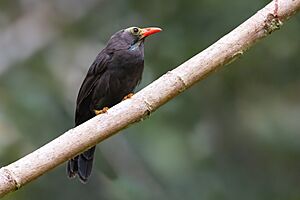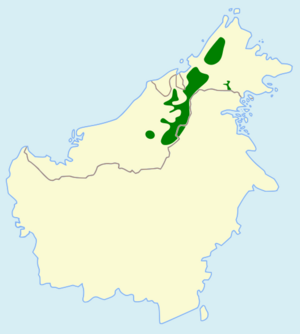Bare-headed laughingthrush facts for kids
Quick facts for kids Bare-headed laughingthrush |
|
|---|---|
 |
|
| Conservation status | |
| Scientific classification | |
 |
|
| Synonyms | |
|
The bare-headed laughingthrush (Melanocichla calva) is a special kind of bird. It belongs to the family of birds called Old World babblers. This bird lives only in the high mountain forests of north-central Borneo. You can find it at elevations from about 750 to 1,800 meters (2,460 to 5,900 feet).
This bird is about 25–26 centimeters (10–10.2 inches) long. Both male and female birds look very similar. Its head is a brownish to greenish yellow color and has no feathers! The area around its lower beak looks a bit bluish. The rest of its body is a dull blackish-brown with some grey. Young birds have more feathers on their heads, covering their forehead up to the top of their head.
A British bird expert named Richard Bowdler Sharpe first described this bird in 1888. For a long time, it was thought to be a type of black laughingthrush. But in 2006, scientists decided it was its own unique species. The bare-headed laughingthrush eats insects like crickets, cicadas, and ants. It finds them in thick plants and vines that grow around trees. Even though it's listed as "least concern" by conservation groups, its home is shrinking. This means its population might be getting smaller.
Contents
About the Bare-headed Laughingthrush
The bare-headed laughingthrush was first described in 1888. It was found in Mount Kinabalu, Borneo. For many years, it was considered a subspecies of the black laughingthrush. However, in 2006, scientists noticed differences in its looks. They decided it was a full species on its own.
The scientific name for the bird is Melanocichla calva. The first part, Melanocichla, comes from ancient Greek words. Melas means black, and kikhlē means thrush. The second part, calva, is from a Latin word meaning bald. This name perfectly describes its unique bare head!
This bird is one of 57 species in the Old World babbler family. These birds live in tropical forests across Asia.
What Does It Look Like?
The bare-headed laughingthrush is about 25–26 centimeters (10–10.2 inches) long. Both male and female birds look alike. Its most striking feature is its head, which has no feathers. It's a brownish to greenish yellow color. The area along its lower jaw has a bluish tint.
The rest of its body is a dull blackish-brown with a hint of grey. Its beak is orange-red, sometimes with a lighter tip. Its eyes are a dark chestnut-brown. The legs are olive-brown, and its feet are yellow. Young birds are a bit different. They have feathers on their forehead and the top of their head, with bare skin only behind their eyes.
This bird looks similar to the black laughingthrush. But you can tell them apart because the bare-headed one has a bare head. It also has a brownish color and a slightly shorter beak, wings, and tail.
What Sounds Does It Make?
The bare-headed laughingthrush makes sounds similar to the black laughingthrush. Its song is a series of 3 to 22 deep, echoing "ooh" or "hoo" notes. These notes are low-pitched.
When two birds sing together, it's called a duet. The "ooh" notes (likely from the male) are joined by loud, funny "yow-yow" or "woh-woh" notes. Sometimes, a loud, grating "weeah" sound is also heard (these are thought to be from the female). Other sounds include a harsh "queer-queer-hoop-hoop-hoop" and a single bleat. This single bleat is used to keep in touch with other birds.
Where Does It Live?
The bare-headed laughingthrush lives only in Borneo. You can find it in the mountain ranges of north-central Borneo. This includes places like Mount Kinabalu and Mount Dulit. It also lives on some smaller mountains in eastern Brunei, Kalimantan (the Indonesian part of Borneo), and the Malaysian states of Sabah and Sarawak.
It is a mountain bird. It lives in broadleaf evergreen forests. It can also be found in forests that are growing back after being cut down, or in areas that have been disturbed by humans. It lives at elevations from about 750 to 1,800 meters (2,460 to 5,900 feet). This bird does not migrate; it stays in the same area all year.
How Does It Behave?
Bare-headed laughingthrushes are usually seen in pairs or small groups. Sometimes, they join larger groups of different bird species looking for food together. They are not as active as some other types of laughingthrushes.
This bird mainly eats insects. Its diet includes crickets, cicadas, and ants. It moves slowly through the lower or middle parts of the forest. It looks for food in thick columns of plants and vines that grow around tree trunks. It might even drop through the vines to catch falling insects. Sometimes, it hangs upside down like a tit bird! It picks ants off bamboo twigs and larger insects from bamboo leaves.
Young birds have been seen in July and possibly in August. Scientists think that these bird groups protect their own areas.
Is It Safe?
The International Union for Conservation of Nature (IUCN) lists the bare-headed laughingthrush as a species of "least concern". This means it has a fairly large range and population. Also, its population is not dropping quickly.
However, in some local areas, it is not very common. Its population is thought to be decreasing. The biggest threats to this bird are its home being destroyed and broken into smaller pieces. But because it lives in mountains, its habitat might be somewhat protected. Even though it hasn't been seen for sale, it could also be threatened by hunting for the cage-bird trade. This trade affects other laughingthrush species in Indonesia.



